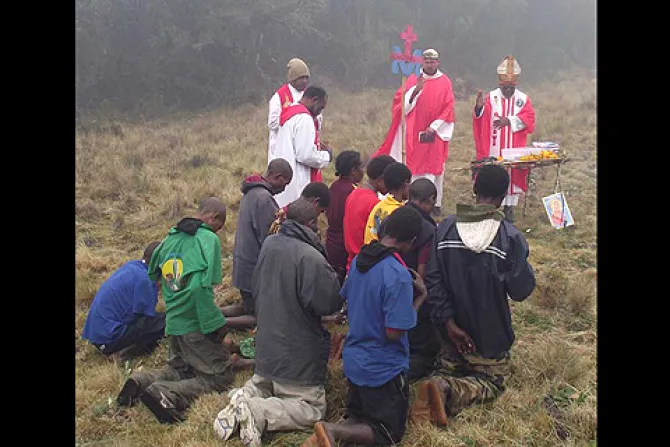Madang, Papua New Guinea, Jul 8, 2014 / 01:03 am
During a pilgrimage on Sunday, a bishop from Papua New Guinea encouraged the local youth to pursue holiness, following upon the model of St. Maria Goretti.
"The forgiving attitude of St. Maria Goretti challenges the mentality and practice of 'payback'," Bishop Rochus Tatamai of Bereina said July 6 at a gathering of young people at Divine Word University in Madang.
"The way the murder of the 11-year-old Italian came about in 1902 reflects very much current social issues and problems in Papua New Guinea," he reflected.
Born in 1890, St. Maria Goretti was the eldest of six children; she was killed at the age of 11 while resisting a rape, and is considered a martyr for chastity.
Coming from a poor family, Maria assisted her mother in housework and in caring for her five younger siblings following her father's death.
In 1902 a neighboring farmhand, Alessandro Serenelli, who had made previous inappropriate comments and sexual advances toward her, attempted to rape Maria in her house. When she resisted, Alessandro stabbed her 14 times.
After being found bleeding to death, she was rushed to the hospital, where she forgave Alessandro, saying: "For the love of Jesus I forgive him … and I want him to be with me in paradise."
Bishop Tatamai encouraged the Papua New Guinean youth to "know how to resist evil and to forgive as did Maria Goretti," reminding them that she "was named patroness of the Catholic youth in Papua New Guinea and the Solomon Islands in 2006."
"The saints also challenge common social practices at odds with Christian values," he added.
He also upheld as an example Bl. Peter To Rot, himself from Papua New Guinea.
Bl. To Rot's parents were converts, and had their son educated by the Missionaries of the Sacred Heart of Jesus, the order for which Bishop Tatamai was ordained a priest in 1989.
Bishop Tatamai is also related to the blessed: the bishop's grandfather, Josef Tatamai, was To Rot's elder brother.
Following his education, Bl. To Rot was appointed a catechist, and when the Japanese invaded New Guinea in 1942, interning foreign missionaries, he was left in charge of his parish.
He continued to lead prayer meetings and to administer the sacraments of baptism and marriage even when the Japanese prohibited all religious activities and promoted polygamy and licentiousness.
After denouncing a local policemen who wanted to practice polygamy, Bl. To Rot was incarcerated, and then was executed by the Japanese, by lethal injection, in the summer of 1945.
Bl. To Rot, Bishop Tatamai said, "shows us the way to overcome the current national crisis: through the same care for the children and the family. Through honesty, dedication, and courage."
"We need models for today's Papua New Guinea: here they are," exclaimed Bishop Tatamai, pointing to St. Maria Goretti and to Bl. Peter To Rot, Papua New Guinea's own "tolay."


